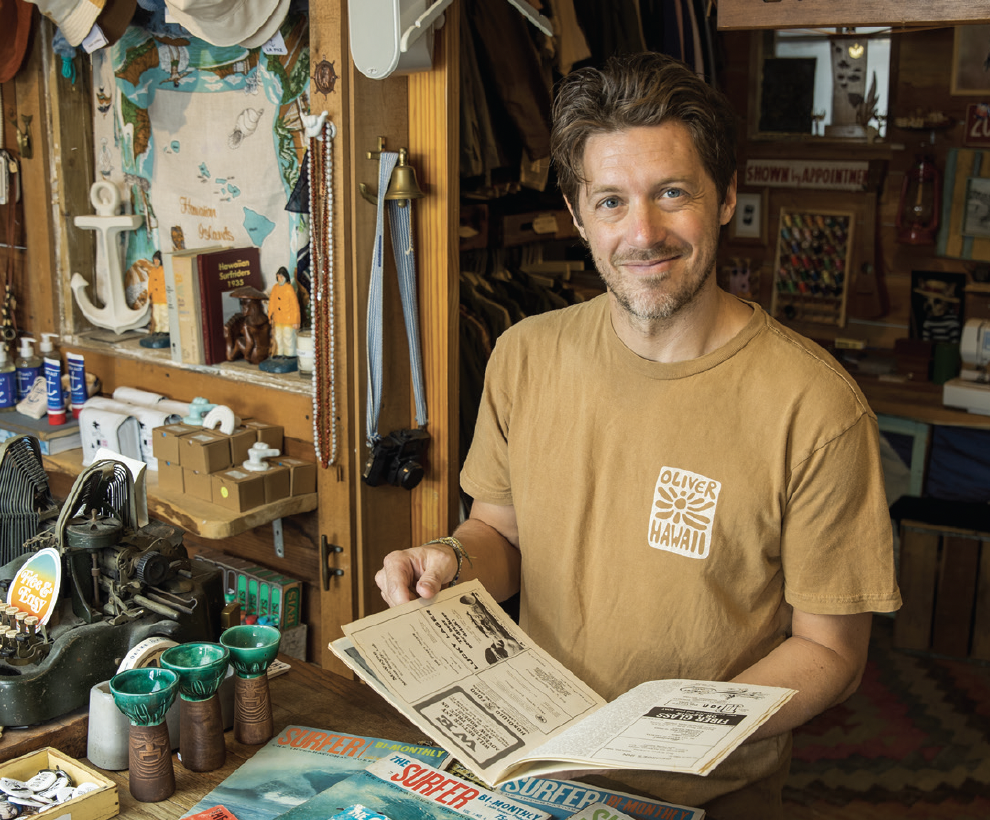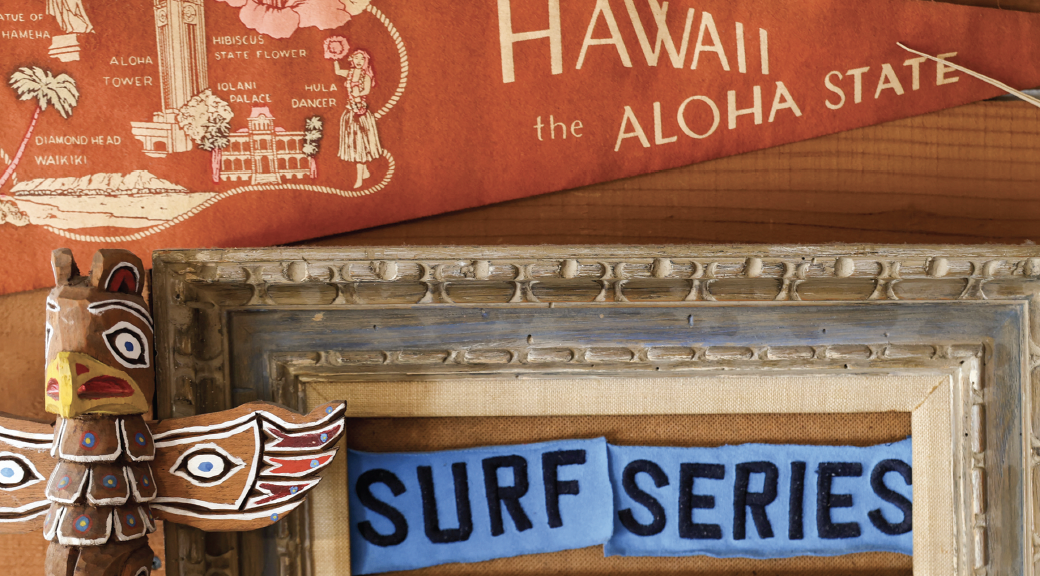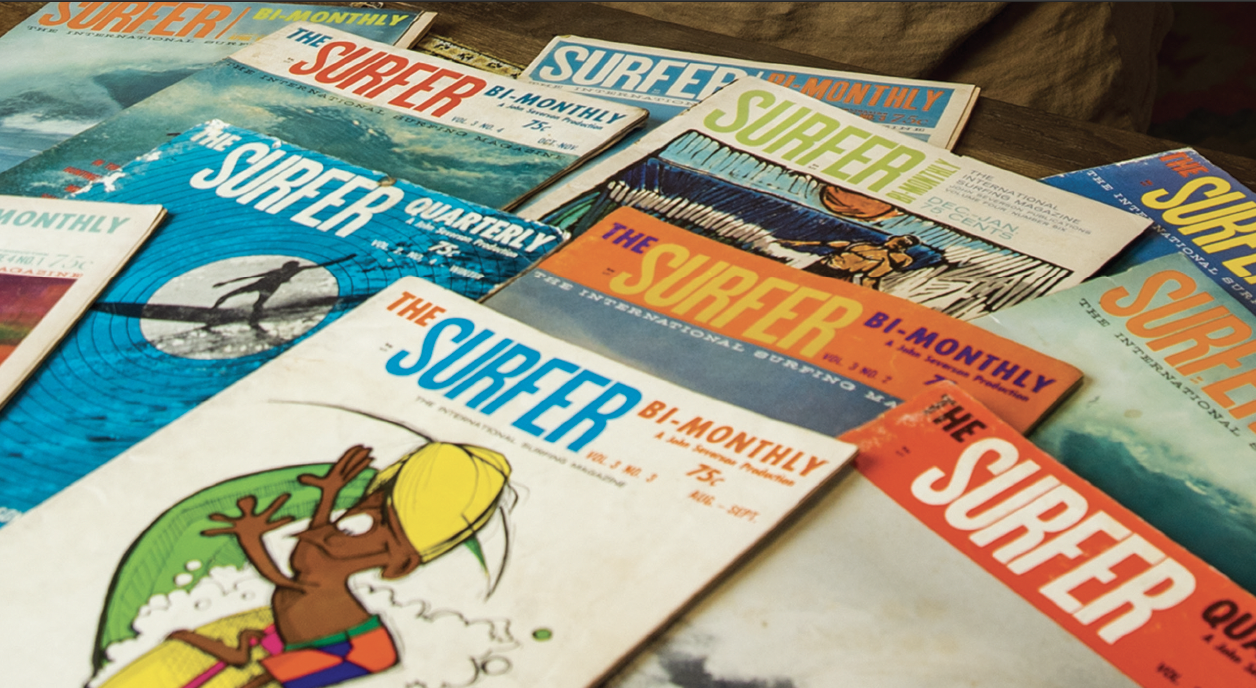Golden Years




“I suppose my first collections started when I was 8 or 9 years old with a pretty extensive Pez dispenser collection,” chuckles Parker Moosman, owner of Oliver Men’s Shop, a clothing and accessory boutique in Kailua. The shop, located in a once distressed area in Kailua town, has become an antique mecca for locals and tourists alike looking for vintage collectibles and clothing. While Oliver sells unique new items, they are known for their vintage Hawaiiana and surf memorabilia.
“In my teens, I got a turntable and my dad’s record collection and then began collecting vinyl albums,” says the avid collector. ‘‘It wasn’t until we moved to Hawai‘i that my attention turned toward surf and Hawaiiana.”
The self-proclaimed The Smith’s fan moved to O‘ahu 15 years ago with his Hawai‘i-born wife, Ali McMahon, after she convinced him Kailua was the place to be after seeing the once sleepy beach town splashed across the media when the then-future U.S. President Barack Obama and his family vacationed there. Moosman and McMahon had tried to start a retail shop in Moosman’s hometown of Seattle but couldn’t find the right combination of space and retail items so it didn't take much to convince him to start a new life in the isles.
They first opened Olive, a women’s boutique shop in 2008 and then the men’s equivalent, Oliver, followed a few years later just a few doors down on Kihapai Street. “We just added an ‘R’,” Moosman muses.
As both shops expanded their inventory, the husband-and-wife team began to decorate the shops with Hawaiiana and other vintage collectibles. According to Moosman, “Our customers would say, ‘Hey you got cool stuff on the walls, I wish I could buy some of this stuff.’” So the duo slowly added more and more collectibles and now close to 90% of their decorations are for sale.
Inside Oliver is an eclectic collection of vintage surf magazines and pamphlets, Polynesian-inspired chalkware busts, vintage surf tees, curios and art books. “It was first and foremost a men’s clothing store with vintage memorabilia on the walls as decorations,” says Moosman, with much of the inspiration of vintage Hawai‘i coming from his wife’s grandfather, John McMahon, who moved to Hawai‘i in the 1930’s to train for the Olympics with swimming champion Duke Kahanamoku. According to the family story, John McMahon was made a Waikiki lifeguard by the legendary waterman and established his roots on O‘ahu.
Many of the store’s collectibles had once been carried away by tourists and visitors streaming off the steamers that once arrived at Aloha Tower or the hundreds of thousands who landed at Honolulu International during the golden age of jet travel. “We focus on finding treasures from the 1940s, ’50s, and ’60s made in Hawai‘i or for the tourist market in Hawai‘i,” says Moosman.
Items like Oliver’s vintage collection of aloha shirts might have been purchased by a G.I. stationed on O‘ahu, worn a handful of times, then taken back to their hometown and stuck and forgotten in a closet once their tour of duty came to an end. Or small curios like a porcelain hula
girl figurine that a tourist stuck inside their carry-on and then placed on a shelf and forgotten about decades later. These are the ideal collectibles Moosman hunts for to place inside his shop.
“Hawai‘i is a melting pot of cultures,” Moosman remarks, “and people come here for many different reasons. But it's a place of vacation and what a wonderful thing that someone can come here and buy something, and they’ll take it home as a reminder of their trip to this beautiful location.”
On display inside the store are cast iron bottle openers, ceramic salt and pepper shakers in the guise of old mariners, matches from bygone hotels, a small hula dancer statue in a nylon green skirt, a mid-’70’s “Luau Toes” tee, and an original printing of Don Blanding‘s 1923
Leaves from a Grass House book of poetry wrapped in its original book cover made of leaves. “It's such a good desktop book, it looks good in your library.”
Another box in the store showcases the first edition of the 1960 Surfer Magazine, then titled The Surfer. Moosman pulled out several of the vintage magazines, spreading them out on the counter and pages through the grainy black and white photos of big waves and surfers. One issue has a guide titled “Surfing for Beginners,” giving tips on footwork and how to catch your first wave. Moosman points out the surf company advertisements, noting many of those original stores are still around today.
A unique item not yet for sale is on display in the back of the store — Ali’s grandfather’s bathing suit emblazoned with the word “Moana” stenciled across the chest. According to Moosman, the 100% wool, torso covering suit was the first thing her grandfather purchased when he moved to Hawai‘i. Moosman wasn’t sure why it says Moana across the chest noting swimwear was sold or rented from beachfront hotels to those wishing to swim in Waikiki. “The suit might be from the Moana Surfrider, but we are unsure.”
Oliver also carries collectibles from outside of Hawai‘i. “I’m kinda all over the place as I collect vinyl records, but not just Hawaiian vinyl, I collect old Jazz and pop records,” says Moosman. “I also collect art books like Matisse and Picasso and also old French magazines that have original tinted lithographs.” Upon the wall near the register is an unassuming framing of the 1969 John Lennon and Yoko Ono pamphlet “War is Over!” from 1969. “We got it at an art auction,” he says. “We’ve got the certificate of authentication and they printed about 500 and spread them all over New York.”
Oliver doesn’t focus on expensive heirloom antiques but focuses on selling day-to-day items useful to people. Moosman stated many of his customers are “locals starting a new family or buying a new house and are searching for cool collectibles to give their home that surf shack vibe. Most of the collectibles are priced between a few bucks to a couple of hundred dollars.
Moosman doesn’t collect tacky items nor does he like to use the word, tchotchke, but he does like things that have a little kitsch to them. “I like colorful things that were thoughtfully made.” He points to a set of garish tiki statues shot glasses that would not have been out of place inside of the old Tahitian Lanai, a Polynesian themed bar inside the now gone Waikikian Hotel. Moosman likes to imagine these shot glasses once held an exotic liquor served to a bewildered tourist inside a bar where hula girls swayed to a South Sea tiki drum rhythm.
He searches all over the globe for his collectibles that were made in or made for the Hawai‘i tourism market. Many of the items were once for sale at the Polynesian themed bazaar, the International Marketplace, where local vendors sold everything from Swiss watches, cheap shell necklaces, tiki statues and velvet paintings.
“I love that a tourist can come to my shop, buy a really cool vintage aloha shirt and take it back to the mainland. And on one Saturday afternoon, he or she can attend a BBQ back home and wear that aloha shirt that has a really cool print and a really good cut that fits them really well and the neighbors will say, ‘what a cool shirt.’”
“I got that in a cool shop in Hawai‘i.”
